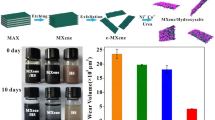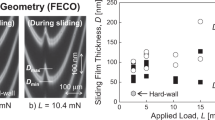Abstract
In nano-scale thin film, the lubricant molecular structure may have more significant impact to lubricating performance than in bulk states. In order to investigate the influence of hydrocarbon base oil molecular structure to lubricating properties, three base oil samples with different molecular structure were synthesized in this study, the molecular structure was detected. Film thickness and friction coefficient were measured by EHD2 ultra thin film measurement system, and wear scar was evaluated by four-ball tester. The base oil with linear molecular structure show lower film thickness and friction coefficient, even the base oil has higher viscosity and viscosity index than other samples, while the branched structure makes the molecule more rigid than linear one, which increase the film thickness and friction coefficient. The linear molecules with high viscosity index sustained oil film at high temperature, which reduced the wear scar.
Graphic Abstract









Similar content being viewed by others
References
Brown, S.F.: Base oil groups: manufacture, properties and performance. Tribol. Lubr. Technol. 71, 32–35 (2015)
Knothe, G., Steidley, K.R.: Kinematic viscosity of biodiesel fuel components and related compounds, Influence of compound structure and comparison to petrodiesel fuel components. Fuel (2005). https://doi.org/10.1016/j.fuel.2005.01.016
Weijun, W., Jun, L., Yifeng, H., Hongwei, S., Songbai, T., Hui, Z.: Influence of different hydrocarbon molecules on physical properties of mineral base oils. China Pet. Process Petrochem. Technol. 19, 33–45 (2017)
Adhvaryu, A., Erhan, S.Z., Sahoo, S.K., Singh, I.D.: Thermo-oxidative stability studies on some new generation API group II and III base oils. Fuel (2002). https://doi.org/10.1016/s0016-2361(01)00210-1
Sarpal, A.S., Sastry, M.I.S., Bansal, V., Singh, I., Mazumdar, S.K., Basu, B.: Correlation of structure and properties of groups I to III base oils. Lubr. Sci. (2012). https://doi.org/10.1002/ls.1172
Kobayashi, M., Saitoh, M., Ishida, K., Yachi, H.: Viscosity properties and molecular structure of lube base oil prepared from fischer-tropsch waxes. J. Jpn. Pet. Inst. 48, 365–372 (2005)
Velkavrh, I., Kalin, M.: Comparison of the effects of the lubricant-molecule chain length and the viscosity on the friction and wear of diamond-like-carbon coatings and steel. Tribol. Int. (2012). https://doi.org/10.1016/j.triboint.2012.01.008
LaFountain, A.R., Johnston, G.J., Spikes, H.A.: The elastohydrodynamic traction of synthetic base oil blends. Tribol. Trans. (2001). https://doi.org/10.1080/10402000108982506
Zhang, J., Tan, A., Spikes, H.A.: Effect of base oil structure on elastohydrodynamic friction. Tribol. Lett. (2017). https://doi.org/10.1007/s11249-016-0791-7
Hsu, S.M., Gates, R.S.: Boundary lubricating films: formation and lubrication mechanism. Tribol. Int. (2005). https://doi.org/10.1016/j.triboint.2004.08.021
Adhvaryu, A., Biresaw, G., Sharma, B.K., Erhan, S.Z.: Friction behavior of some seed oils: biobased lubricant applications. Ind. Eng. Chem. Res. (2006). https://doi.org/10.1021/ie051259z
Adhvaryu, A., Erhan, S.Z., Singh, I.D.: Application of quantitative 13C nuclear magnetic resonance spectroscopy to the characterization of solvent-refined aromatic-rich lubricant base oils. Lubr. Sci. (2002). https://doi.org/10.1002/ls.3010150102
Zhang, X.A., Zhao, Y., Ma, K., Wang, Q.: Friction behavior and wear protection ability of selected base lubricants. Friction (2016). https://doi.org/10.1007/s40544-016-0106-x
Liu, P., Lu, J., Yu, H., Ren, N., Lockwood, F.E., Wang, Q.J.: Lubricant shear thinning behavior correlated with variation of radius of gyration via molecular dynamics simulations. J. Chem. Phys. (2017). https://doi.org/10.1063/1.4986552
Ning, Y.N., LI, M.J., Jiang, T.: Research of 1-butent oligomer catalyzed by bis (n-butycyclopentadienyl) zirconium dichloride. Chem. Eng. 28, 70–73 (2014)
Gingell, R., Bennick, J.E., Malley, L.A.: Subchronic inhalation study of 1-hexene in fischer 344 rats. Drug Chem. Toxicol. (1999). https://doi.org/10.3109/01480549909042529
Wang, W., Jiang, S., Shen, Y., Xia, S., Xu, J.: Synthesis of high viscosity index base stock and study on the lubricating properties. Ind. Lubr. Tribol. (2016). https://doi.org/10.1108/ilt-02-2015-0020
Spikes, H.A., Cann, P.M.: The development and application of the spacer layer imaging method for measuring lubricant film thickness. Proc. Inst. Mech. Eng. Part J (2001). https://doi.org/10.1243/1350650011543529
Cann, P.M., Spikes, H.A., Hutchinson, J.: The development of a spacer layer imaging method (slim) for mapping elastohydrodynamic contacts. Tribol. Trans. (1996). https://doi.org/10.1080/10402009608983612
Shea, T.M., Gunsel, S.: Modeling base oil properties using NMR spectroscopy and neural networks. Tribol. Trans. (2003). https://doi.org/10.1080/10402000308982629
Biresaw, G., Bantchev, G.B.: Pressure viscosity coefficient of vegetable. Oils Tribol. Lett. (2013). https://doi.org/10.1007/s11249-012-0091-9
Kioupis, L.I., Maginn, E.J.: Impact of molecular architecture on the high-pressure rheology of hydrocarbon fluids. J. Phys. Chem. (2000). https://doi.org/10.1021/jp000966x
Muraki, M.: Molecular structure of synthetic hydrocarbon oils and their rheological properties governing traction characteristics. Tribol. Int. (1987). https://doi.org/10.1016/0301-679X(87)90063-6
Biresaw, G., Bantchev, G.B.: Pressure viscosity coefficient of vegetable oils. Tribol. Lett. (2013). https://doi.org/10.1007/s11249-012-0091-9
Greaves, M.: Pressure viscosity coefficients and traction properties of synthetic lubricants for wind turbine gear systems. Lubr. Sci. (2012). https://doi.org/10.1002/ls.172
Cousseau, T., Björling, M., Graça, B., Campos, A., Seabra, J., Larsson, R.: Film thickness in a ball-on-disc contact lubricated with greases, bleed oils and base oils. Tribol. Int. (2012). https://doi.org/10.1016/j.triboint.2012.04.018
Yasuda, K., Armstrong, R., Cohen, R.: Shear flow properties of concentrated solutions of linear and star branched polystyrenes. Rheol. Acta (1981). https://doi.org/10.1007/bf01513059
Castillo-Tejas, J., Alvarado, J.F., González-Alatorre, G., Luna-Bárcenas, G., Sanchez, I.C., Macias-Salinas, R., Manero, O.: Nonequilibrium molecular dynamics of the rheological and structural properties of linear and branched molecules. Simple shear and poiseuille flows; instabilities and slip. J. Chem. Phys. (2005). https://doi.org/10.1063/1.1955524
Granick, S.: Motions and relaxations of confined liquids. Science (1991). https://doi.org/10.1126/science.253.5026.1374
Suraya, A.R., Luckham, P.F., Lawrence, C.J.: Shear thinning and frequency dependent behaviour of adsorbed polymer layers: part I. experimental aspects and a first order analysis. J. Non-Newtonian Fluid Mech. (2008). https://doi.org/10.1016/j.jnnfm.2007.04.016
Bair, S., Vergne, P., Querry, M.: A unified shear-thinning treatment of both film thickness and traction in EHD. Tribol. Lett. (2005). https://doi.org/10.1007/s11249-004-1770-y
Liu, Y., Wang, Q.J., Krupka, I., Hartl, M., Bair, S.: The shear-thinning elastohydrodynamic film thickness of a two-component mixture. J. Tribol. (2008). https://doi.org/10.1115/1.2842298
Zolper, T.J., He, Y., Delferro, M., Shiller, P., Doll, G., LotfizadehDehkordi, B., Ren, N., Lockwood, F., Marks, T.J., Chung, Y., Greco, A., Erdemir, A., Wang, Q.: Investigation of shear-thinning behavior on film thickness and friction coefficient of polyalphaolefin base fluids with varying olefin copolymer content. J. Tribol. (2017). https://doi.org/10.1115/1.4033716
Guangteng, G., Spikes, H.A.: Boundary film formation by lubricant base fluids. Tribol. Trans. (1996). https://doi.org/10.1080/10402009608983551
Zolper, T.J., Seyam, A.M., Chen, C., Jungk, M., Stammer, A., Stoegbauer, H., Marks, J.T., Chung, Y., Wang, Q.: Lubrication properties of polyalphaolefin and polysiloxane lubricants: molecular structure-tribology relationships. Tribol. Lett. (2013). https://doi.org/10.1007/s11249-012-0030-9
Funding
This work was funded by the Natural Science Foundation of Shandong Province (CN) [Grant No. ZR2019BEE073].
Author information
Authors and Affiliations
Corresponding authors
Additional information
Publisher's Note
Springer Nature remains neutral with regard to jurisdictional claims in published maps and institutional affiliations.
Rights and permissions
About this article
Cite this article
Wang, W., Li, P., Sheng, S. et al. Influence of Hydrocarbon Base Oil Molecular Structure on Lubricating Properties in Nano-scale Thin Film. Tribol Lett 67, 111 (2019). https://doi.org/10.1007/s11249-019-1222-3
Received:
Accepted:
Published:
DOI: https://doi.org/10.1007/s11249-019-1222-3




